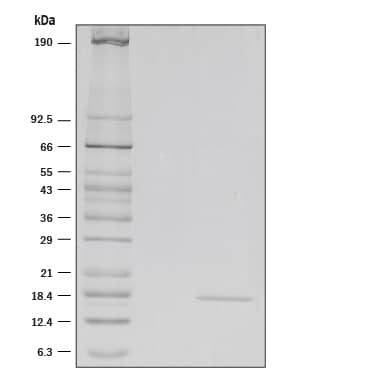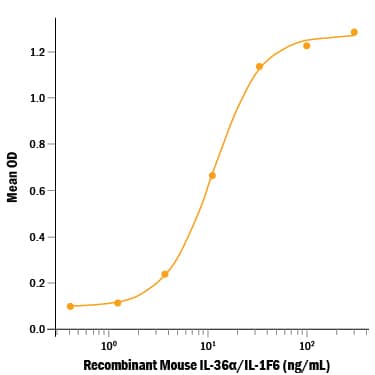Recombinant Mouse IL-36 alpha/IL-1F6 (aa 8-160) Protein
R&D Systems, part of Bio-Techne | Catalog # 7059-ML

Key Product Details
Product Specifications
Source
Arg8-His160
Purity
Endotoxin Level
N-terminal Sequence Analysis
Predicted Molecular Mass
SDS-PAGE
Activity
The ED50 for this effect is typically 3-18 ng/mL.
Reviewed Applications
Read 1 review rated 4 using 7059-ML in the following applications:
Scientific Data Images for Recombinant Mouse IL-36 alpha/IL-1F6 (aa 8-160) Protein
Recombinant Mouse IL-36 alpha/IL-1F6 (aa 8-160) Protein Bioactivity
Recombinant Mouse IL-36 alpha/IL-1F6 (aa 8‑160) (Catalog # 7059‑ML) induces IL‑6 secretion in the NIH‑3T3 mouse embryonic fibroblast cell line. The ED50 for this effect is 3-18 ng/mL.Recombinant Mouse IL-36 alpha/IL-1F6 (aa 8-160) Protein SDS-PAGE
1 μg/lane of Recombinant Mouse IL-36 alpha/IL-1F6 (aa 8-160) was resolved with SDS-PAGE under reducing (R) conditions and visualized by silver staining, showing a single band at 17 kDa.Formulation, Preparation and Storage
Carrier Free
What does CF mean?CF stands for Carrier Free (CF). We typically add Bovine Serum Albumin (BSA) as a carrier protein to our recombinant proteins. Adding a carrier protein enhances protein stability, increases shelf-life, and allows the recombinant protein to be stored at a more dilute concentration. The carrier free version does not contain BSA.
What formulation is right for me?In general, we advise purchasing the recombinant protein with BSA for use in cell or tissue culture, or as an ELISA standard. In contrast, the carrier free protein is recommended for applications, in which the presence of BSA could interfere.
Carrier: 7059-ML
| Formulation | Lyophilized from a 0.2 μm filtered solution in MOPS, NaCl, TCEP and EDTA with BSA as a carrier protein. |
| Reconstitution | Reconstitute at 100 μg/mL in PBS containing at least 0.1% human or bovine serum albumin. |
| Shipping | The product is shipped with polar packs. Upon receipt, store it immediately at the temperature recommended below. |
| Stability & Storage | Use a manual defrost freezer and avoid repeated freeze-thaw cycles.
|
Carrier Free: 7059-ML/CF
| Formulation | Lyophilized from a 0.2 μm filtered solution in MOPS, NaCl, TCEP and EDTA with Trehalose. |
| Reconstitution | Reconstitute at 100 μg/mL in PBS. |
| Shipping | The product is shipped at ambient temperature. Upon receipt, store it immediately at the temperature recommended below. |
| Stability & Storage | Use a manual defrost freezer and avoid repeated freeze-thaw cycles.
|
Background: IL-36 alpha/IL-1F6
IL‑36 alpha, previously called IL‑1F6 and FIL1 epsilon (family of IL‑1 member epsilon), is a member of the IL‑1 family which includes IL‑1 beta, IL‑1 alpha, IL‑1ra, IL‑18, and novel family members IL‑36 Ra (IL‑1F5), IL‑36 beta (IL‑1F8), IL‑36 gamma (IL‑1F9), IL‑37 (IL‑1F7) and IL‑1F10 (14). All family members show a 12 beta‑strand, beta‑trefoil configuration, and are believed to have arisen from a common ancestral gene (1, 2). IL‑36 alpha is an 18‑22 kDa, 160 amino acid (aa) intracellular and secreted protein that contains no signal sequence, no prosegment and no potential N‑linked glycosylation sites (1‑3). It can be externalized non‑specifically in response to LPS and ATP‑induced activation of the P2X7 receptor (5). Full‑length recombinant IL‑36 alpha is less active than endogenous IL‑36 alpha, but trimming of the N‑termini enhances its activity (6). Mouse IL‑36 alpha (aa 8‑160) shares 83% aa sequence identity with rat IL‑36 alpha, 54‑60% with human, rabbit, equine and bovine IL‑36 alpha, and 27‑57% aa sequence identity with other novel IL‑1 family members. IL‑36 alpha is mainly found in skin and lymphoid tissues, but also in fetal brain, trachea, stomach and intestine (1, 3, 7). It is expressed by monocytes, B and T cells (1, 2). The receptor for IL‑36 alpha is a combination of IL‑1 Rrp2 (also called IL‑1 RL2 or IL‑1 R6), mainly found in epithelia and keratinocytes, and the widely expressed IL‑1 RAcP (3, 6, 7). IL‑36 alpha, beta and gamma all activate NF‑ kappaB and MAPK pathways in an IL‑1 Rrp2 dependent manner, and induce production of inflammatory cytokines and chemokines such as CXCL8/IL‑8 (7). IL‑36 alpha and other family members are overexpressed in psoriatic skin lesions, and transgenic overexpression of IL‑36 alpha in skin keratinocytes produces epidermal hyperplasia (6‑9). IL‑36 alpha is present in kidney tubule epithelia; it is highly overexpressed in tubulointerstitial lesions in mouse models of chronic glomerulonephritis, lupus nephritis and diabetic nephritis (10). IL‑36 alpha is induced by inflammation in adipose tissue‑resident alternately activated (M2) macrophages, and reduces adipocyte differentiation (11).
References
- Smith, D.E. et al. (2000) J. Biol. Chem. 275:1169.
- Dunn, E. et al. (2001) Trends Immunol. 22:533.
- Barksby, H.E. et al. (2007) Clin. Exp. Immunol. 149:217.
- Dinarello, C. et al. (2010) Nat. Immunol. 11:973.
- Martin, U. et al. (2009) J. Immunol. 183:4021.
- Blumberg, H. et al. (2007) J. Exp. Med. 204:2603.
- Towne, J.E. et al. (2004) J. Biol. Chem. 279:13677.
- Blumberg, H. et al. (2010) J. Immunol. 185:4354.
- Johnston, A. et al. (2011) J. Immunol. 186:2613.
- Ichii, O. et al. (2010) Lab. Invest. 90:459.
- van Asseldonk, E.J.P. et al. (2010) Obesity 18:2234.
Long Name
Alternate Names
Gene Symbol
UniProt
Additional IL-36 alpha/IL-1F6 Products
Product Documents for Recombinant Mouse IL-36 alpha/IL-1F6 (aa 8-160) Protein
Product Specific Notices for Recombinant Mouse IL-36 alpha/IL-1F6 (aa 8-160) Protein
For research use only

